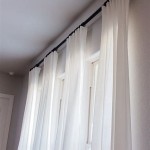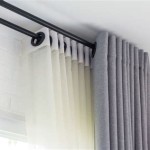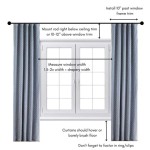Understanding Support Brackets for Curtain Rods
Support brackets for curtain rods are essential hardware components used to securely hold curtain rods in place. These brackets are designed to attach to a wall or other mounting surface and provide stable support for the rod, allowing curtains to hang properly and function as intended. The selection and proper installation of support brackets are crucial for ensuring the safe and effective operation of any window treatment system.
The functionality of support brackets extends beyond simply holding up a curtain rod. They play a vital role in distributing the weight of the curtains, preventing the rod from bowing or sagging. This is particularly important for heavier curtains or wider windows, where the load on the rod can be significant. A properly chosen and installed support bracket will enhance the aesthetic appeal of a window treatment by allowing curtains to hang uniformly and maintain their intended shape.
Additionally, support brackets contribute to the overall safety and durability of the curtain system. Inadequate or poorly installed brackets can lead to the rod detaching from the wall, potentially causing damage to the wall itself, the curtains, or even posing a safety hazard to individuals in the vicinity. Therefore, understanding the different types of support brackets, their weight capacities, and proper installation techniques is essential for a successful and long-lasting curtain installation.
Types of Support Brackets
A wide variety of support brackets are available, each designed to cater to specific curtain rod styles, mounting situations, and aesthetic preferences. Understanding these different types will facilitate the selection of the most appropriate bracket for a given application.
Standard Brackets: These are the most common type of support bracket and are typically used for lightweight to medium-weight curtains. They usually consist of a single arm extending from the mounting plate that holds the curtain rod. Standard brackets are often made of metal, such as steel or aluminum, and may have a simple, utilitarian design. They are generally suitable for basic curtain installations where the weight of the curtains is not excessive.
Heavy-Duty Brackets: As the name suggests, heavy-duty brackets are designed to support heavier curtains and rods. These brackets are typically made of thicker metal and have a more robust construction than standard brackets. They may also feature multiple arms or braces for added strength and stability. Heavy-duty brackets are often used for curtains made of thick fabrics, such as velvet or blackout materials, or for wider windows where the rod needs to span a larger distance.
Adjustable Brackets: Adjustable brackets allow the distance between the curtain rod and the wall to be adjusted. This can be useful for accommodating obstructions, such as window trim or protruding objects, or for creating a specific aesthetic effect. Adjustable brackets typically feature a telescoping arm or a sliding mechanism that allows the depth of the bracket to be varied. They are available in a range of styles and weight capacities.
Ceiling Mount Brackets: In situations where wall mounting is not feasible or desirable, ceiling mount brackets provide an alternative solution. These brackets attach directly to the ceiling and support the curtain rod from above. Ceiling mount brackets are often used in rooms with unusual window configurations or in spaces where a more minimalist aesthetic is desired. They require careful installation to ensure that they are securely attached to the ceiling joists.
Hidden Brackets: Hidden brackets are designed to be concealed from view, creating a cleaner and more streamlined appearance. These brackets typically consist of a small mounting plate that attaches to the wall and a corresponding receptacle on the end of the curtain rod. The rod slides onto the mounting plate, concealing the bracket from view. Hidden brackets are often used in conjunction with decorative curtain rods to enhance their aesthetic appeal.
Factors to Consider When Choosing Support Brackets
Selecting the correct support brackets for a curtain rod involves considering several factors to ensure that the brackets are strong enough to support the weight of the curtains, compatible with the rod, and appropriate for the mounting surface. Neglecting these factors can lead to instability, damage, or even failure of the curtain system.
Weight Capacity: The weight capacity of the support brackets is perhaps the most critical factor to consider. It is essential to select brackets that can safely support the weight of the curtains and the rod, with a margin of safety to account for dynamic loads, such as when the curtains are being opened or closed. The weight capacity of the brackets is typically specified by the manufacturer and should be carefully reviewed before making a purchase. Overloading the brackets can lead to bending, sagging, or even breakage.
Rod Compatibility: The support brackets must be compatible with the diameter and style of the curtain rod. Some brackets are designed to accommodate specific rod sizes, while others are more versatile. It is important to ensure that the rod fits snugly and securely within the bracket to prevent it from slipping or falling. The style of the bracket should also complement the style of the rod, creating a cohesive and visually appealing window treatment.
Mounting Surface: The type of mounting surface (e.g., drywall, wood, plaster) will also influence the selection of support brackets. Different mounting surfaces require different types of fasteners to ensure a secure and stable attachment. For example, drywall requires the use of drywall anchors, while wood requires wood screws. It is essential to use the appropriate fasteners for the mounting surface to prevent the brackets from pulling loose or damaging the wall. If uncertain about the type of wall construction, consult with a professional before proceeding with the installation.
Number of Brackets: The number of support brackets required will depend on the length of the curtain rod and the weight of the curtains. As a general rule, a bracket should be placed every 3-4 feet to prevent the rod from sagging. For heavier curtains or longer rods, additional brackets may be necessary. It is always better to err on the side of caution and use more brackets than fewer to ensure adequate support.
Aesthetic Considerations: While functionality is paramount, aesthetic considerations should also play a role in the selection of support brackets. The brackets should complement the overall style of the room and the window treatment. Brackets are available in a variety of finishes, such as brushed nickel, oil-rubbed bronze, and black, allowing them to be coordinated with other hardware and décor elements. Consider choosing brackets that blend seamlessly with the rod and curtains, or that provide a subtle accent to the window treatment.
Proper Installation Techniques
Even the highest quality support brackets will be ineffective if they are not installed properly. Following proper installation techniques is crucial for ensuring the stability and safety of the curtain rod system. This involves careful planning, accurate measurements, and the use of appropriate tools and fasteners.
Planning and Preparation: Before beginning the installation, it is important to plan the layout of the curtain rod and brackets. Determine the desired height and width of the curtains, and mark the location of the brackets on the wall. Use a level to ensure that the brackets are aligned horizontally. Gather all the necessary tools and materials, including a drill, screwdriver, measuring tape, level, and appropriate fasteners. Clear the work area and protect the floor from damage.
Locating Wall Studs: Ideally, support brackets should be mounted directly into wall studs for maximum stability. Wall studs are vertical framing members that provide structural support to the wall. Use a stud finder to locate the studs behind the drywall. If a stud cannot be located at the desired location for the bracket, use a drywall anchor to provide a secure attachment. Drywall anchors are designed to grip the drywall and prevent the screws from pulling loose.
Using Appropriate Fasteners: The type of fasteners used to attach the support brackets to the wall will depend on the mounting surface. For wood studs, use wood screws that are long enough to penetrate the stud by at least 1 inch. For drywall, use drywall anchors that are rated for the weight of the curtains and rod. For plaster walls, use plaster anchors or toggle bolts. Always follow the manufacturer's instructions when installing fasteners and ensure that they are tightened securely.
Ensuring Proper Alignment and Leveling: Accurate alignment and leveling are essential for ensuring that the curtain rod hangs straight and the curtains drape evenly. Use a level to check the horizontal alignment of the brackets before tightening the screws. If necessary, make adjustments to ensure that the brackets are perfectly level. Misaligned brackets can cause the rod to sag or the curtains to hang unevenly.
Testing and Adjustments: After installing the support brackets, test their stability by gently tugging on them. If the brackets feel loose or wobbly, tighten the screws or consider using larger or stronger fasteners. Once the brackets are securely mounted, install the curtain rod and hang the curtains. Check the overall appearance of the window treatment and make any necessary adjustments. Ensure that the curtains move smoothly and that the rod is not sagging.
By carefully considering the type of support brackets, the weight of the curtains, the mounting surface, and proper installation techniques, it is possible to create a safe, functional, and aesthetically pleasing window treatment system that will last for years to come.

2pcs Set Adjustable Metal Curtain Rod Bracket Hooks With Screws Roman Pole Holder Clothes Rail Ccessories Lazada Singapore

Support Curtain Rod Holder For Wall Adjustable Bracket Brackets
2set Curtain Rod Mount Holder Heavy Duty Closet Rail Fixed Hardware Open Flange Seat Socket Stainless Steel Wardrobe Bracket End

Metal Center Support Bracket For 2 1 4 Curtain Rod Return Each

Forged Iron Low Profile Center Support Bracket Estate Collection Bestwindowtreatments Com

Lumi Brushed Nickel Metal Double 7 In Projection Curtain Rod Bracket Set Of 4 B1512k01 1ebn4 The Home

Curtain Rod Holder Heavy Double Support Bracket

Kirsch Continental Curtain Rod Center Support Bracket Williams Drapery Hardware And Wooden Rods

Oil Rubbed Bronze Steel Single 4 In Projection Curtain Rod Bracket Set Of 2 541798 The Home

Brass Antique Double Curtain Rod Brackets Set








